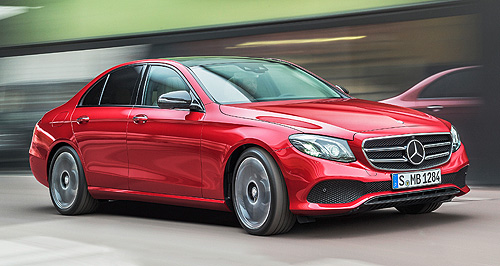Make / Model Search
News - Mercedes-BenzMercedes takes slow road with driverless carsSafety first: Mercedes-Benz vehicles such as the latest E-Class are technically capable of a level of automated driving, but they lack the back-up systems required to make autonomous travel safe. Top Mercedes engineer says baby steps needed in developing safe autonomous cars14 Jul 2016 MERCEDES-BENZ technology expert Jochen Haab has defended the leading prestige car manufacturer’s cautious approach to autonomous vehicles, saying there are still too many “what ifs” about the safety of such systems to jump fully into driverless technology. During a visit to Australia this week, the Mercedes R&D validation manager was asked for his opinion about the well-publicised fatal crash of a Tesla Model S while apparently in autopilot in the United States recently. He said such accidents reaffirmed Mercedes’ step-by-step approach to the introduction of new safety systems that were currently only at the second level of a five-level path to driverless capability. “It (the Tesla crash) raises questions, yes, and of course we discuss it internally and we try to get information – we look at the situation – but actually to us it confirms the way we do it,” he said. “The last couple of years, since we introduced Distronic steering assist in the generation three cars that we sell today, people often come out and say, ‘Hey, why don’t you do more? You could do more – why don’t you? Why do you want to take those small steps?’“We say that is the safe way to do it – one step at a time. Then, when are confident, we spread it out across the range and then take the next step. That’s what we do.” Mr Haab said Mercedes recently turned a standard new-generation E-Class model into an automated driving vehicle for demonstration purposes in Las Vegas, simply by reprogramming the software. He said the car had the hardware and sensors to drive without driver input. However, Mr Haab said fully automated cars would need to have back-up systems to items such as radar sensors and cameras to take over should, for example, a stone smash the radar or a windscreen crack block the camera’s view. He said that because legislation in most countries did not allow fully automated steering capability above 10km/h – effectively restricting it to automated parking – Mercedes had not fitted such back-up systems to any of its cars. “Yes, we can make the software drive autonomously,” he said. “We have all the steering, braking and accelerating devices there, along with the sensors and the software, but we don’t have the back-up systems for the ‘what ifs’. “They are very seldom, but you have to look at them. Statistically they will happen. From that perspective, we shouldn’t do it yet, and we don’t do it because we don’t have the legal permission yet, and it is a cost issue too.” Mr Haab, an engineer, said the US Insurance Institute for Highway Safety (IIHS) recently told Mercedes that its current-generation vehicles with partial automation had now covered two billion kilometres in that country without incident. Asked to define incident, Mr Haab said: “Nobody filed a court case against us. “But that does not mean we did not have any accidents. Accidents are inevitable, and ‘Vision Zero’ is a vision, but we have to get close.” Mr Haab said the next step in automated vehicles would be to introduce highly automated driving on separated highways – “a true motorway with true separation between, not just a line or grass, and no crossing traffic, no intersections, no pedestrians or bicyclists or anything.” He said that even when fitted with GPS and sensors to track line markings and side barriers, vehicles would rely on other cars heading in the same direction at approximately to same speed to be safe at highway speeds. Mr Haab said Mercedes’ grille-mounted radar system could “see” three cars ahead in traffic, creating an effective buffer between the vehicle and any potential accident. He said this surrounding traffic was so important to safe automated driving that a driver travelling on a vacant road, say at 3am, could not be permitted to drive autonomously under this level of technology.  Read more |
Click to shareMercedes-Benz articlesResearch Mercedes-Benz Motor industry news |












Facebook Twitter Instagram